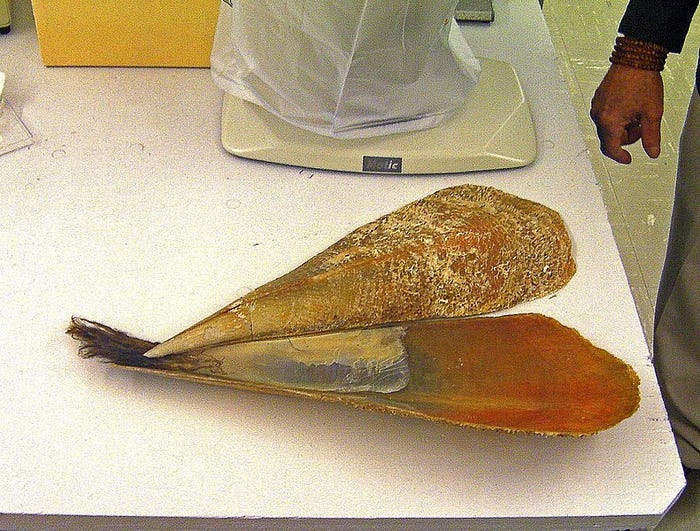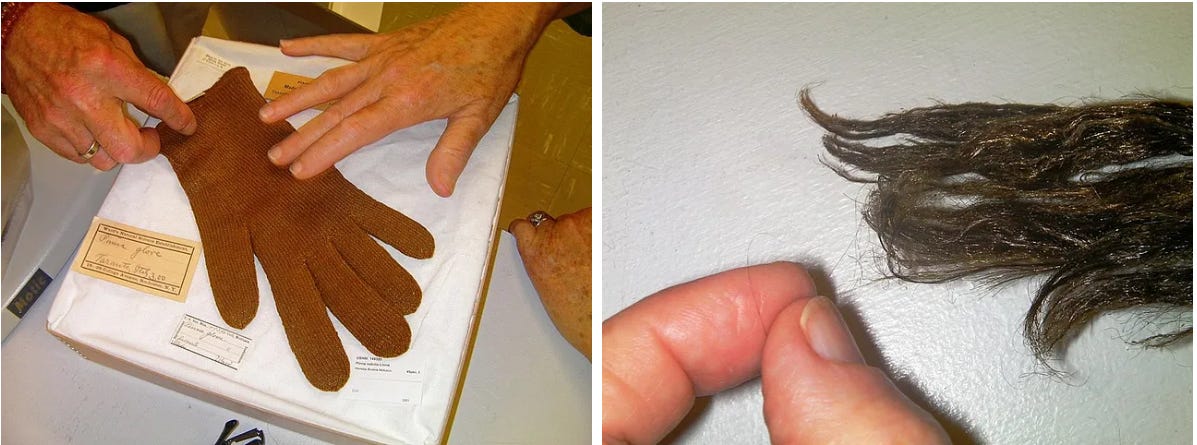The Ancient Mediterranean Had Its Own Silk Harvested From The Sea
This mysterious thread seduced the Roman Empire and even traveled to China

In2013, China initiated the Belt and Road Initiative, originally designed to link Europe and East Asia via infrastructure projects. Some nicknamed it “The New Silk Road.” You don’t need much imagination to understand why it picked up that moniker.
The original Silk Road was a 4,000-mile caravan tract that eventually reached the Mediterranean and traveled across the sea. At one point, it linked Rome to China through a series of merchant middlemen. Ideas, religions, and goods passed each way.
But one of the main flows was silk to the west. This exotic material cultivated from silkworms captivated distant lands that, conventional wisdom says, had nothing like this fabric domestically.
But the Mediterranean region had its natural silk, which was so fine you couldn’t feel it in your hand. Its brownish color also turned to a shiny gold hue in the sun and fetched staggering prices. The material’s origin is also so strange that it makes silk from secret worms look humdrum and boring.
There’s evidence it even traveled east on the Silk Road to China.
This mystery material is sea silk or byssus. It has a controversial and mysterious past, but before we get to this, let’s examine how you get silk from the sea.
The Pinna Nobilis
University of Victoria archeologist Brendan Burke says the Pinna Nobilis is the largest bivalve (two-hinged shell) mollusk in the Mediterranean. It can reach nearly four feet and lives from a few feet to a couple hundred deep. It was also once plentiful around the Aegean.
People harvested this bivalve for food, its shell, and an interesting characteristic. This mollusk creates a material known as byssal threads, which starts from its foot and attaches itself to the seafloor. Scientists have been studying its adhesive properties since the nineteenth century.
The thread itself is amazing.
Water doesn’t dissolve it.
It’s strong enough to hold the Pinna firm against strong ocean currents.
One section is like rubber, transforming into a stiff nylon-like material seamlessly.
The threads can also be harvested.

The threads can be removed once the animal is dislodged from its anchor and pried open. They must still be washed with soap, left to dry, combed and carded, then spun into thread. Burke says it’s believed you get about three ounces of material per pound of mollusk.
Sea silk’s history is a mixture of the proven and speculative. The further back in time you go, the less concrete it gets. We’ll start with the more solid evidence.
The Knowns Of Sea Silk
“And it did not suffice to plant and sow for a tunic, if it had not also proved possible to fish for clothes. For fleeces also come from the sea, inasmuch as the finer shells of mossy woolliness are adorned with them.”
— Tertullian, De Pallio 3.6.2
Dr. Felicitas Maeder, from the Natural History Museum of Basel, Switzerland, explains that solid evidence of sea silk first appeared in the Mediterranean during the early Roman Empire. A Roman officer named Tertullian (above) mentioned it near 200 AD, decrying the fabric’s exorbitant cost.
Furthermore, Maeder says the oldest sample of sea silk was discovered in the former Roman city of Aquincum (Budapest), towards the Empire’s frontier. In 1912, a researcher named Hollendonner found the material in an odd limestone grave. Buried within was a mummy wrapped in resin-covered linen.
The remnants of a brown fabric were discovered on the leg of the skeleton. The fabric was presented to the Royal Hungarian Society for Natural Science and published in their journal. The fibers were compared to Pinna Nobilis byssus and matched. They dated the find to about the fourth century AD.
In Maeder’s “Sea Silk Project” with the Natural History Museum, she says even emperors commented on the material. Emperor Diocletian’s Edict on Maximum Prices in 301AD, enacted to control inflation, mentions sea silk. Maeder says a tunic made of the byssus fibers is listed for 48,000 denari versus a few hundred for a cheap garment.
But the most interesting documentation comes from the Far East. Elena Soriga of the Oriental University of Naples, Italy, and Alfredo Carannante from the Research Institute for Archaeology and Ethnology reveal that Chinese writings record a special material coming from the West.
Chronicles from the third century AD mention shui-yang (water sheep) hair or fabric referred to as hai-his-pu (western cloth from the sea.) So, the traditional path on the appropriately named road for silk wasn’t only from east to west. A certain sea silk went in the opposite direction.
However, evidence gets murkier as we travel before the first millennium AD.
Terms Change Over Time And Bronze Age Sea Silk
According to Brendan Burke, you can find a term close to byssus on the Rosetta Stone, but its actual translation in ancient Egyptian means the linen of the king. In fact, “byssus” can mean linen, cotton, or some even argue sea silk as you head towards the Bronze Age. However, the word is generally just a descriptor for lavish and fine material during this time.
Burke even says byssus is mentioned forty times in the Bible but isn’t associated with marine silk. Soriga and Carannante say the term is usually used in Hebrew and Akkadian to refer to a material made from plants, such as a special fabric worn by kings or priests. However, there is some circumstantial evidence of Bronze Age sea silk creation.
Pinna Nobilis shells have been found at Minoan ruins at Knossos and Mycenae. Burke finds shell remains at the latter Mycenean ruins in a building called the Cult Center, which is extremely interesting. A fresco on the wall shows a priestess holding a fiery item.

While many believe it is grain, Burke thinks it’s a version of the Pinna Nobilis with a red hue. The archeologist sees the shells in the room as strong evidence. Although this is all just speculation for now, it doesn’t necessarily mean that the Bronze Age Greeks harvested sea silk.
But there’s one extra interesting tidbit about this story about ancient silk from the sea: It can still be produced today.
A Last Maker And Weaver Of Sea Silk
“Silk is usually made…by silkworms — but there is another, much rarer, cloth known as sea silk or byssus, which comes from a clam. Chiara Vigo is thought to be the only person left who can harvest it, spin it and make it shine like gold.”
— Chiara Vigo: The last woman who makes sea silk, Max Paradiso, BBC News
In his article above, Max Paradiso writes about his visit to Sardinia, an island off the coast of Italy, where he visited a weaver of sea silk. Chiara Vigo had the author close his eyes while she laid a piece of fabric in his hands. It was so light; Paradiso couldn’t feel it.
He also tells how the fabric goes from brown to shining like gold when exposed to sunlight.
Vigo dives for Pinna Nobilis herself. Acquiring a few hundred grams of material may require as many as four hundred dives. She can harvest the byssus without hurting the mollusks and weave it into thread. She turns these into fabric creations.
Despite the effort and rare skill, Vigo doesn’t sell the unique items she makes but gives them away to “people in need.” She also mixes prayers into her labor, reminding me of something just out of my grasp. Then, a picture in Paradiso’s article made it clearer.
There’s a photo of Vigo holding a Pinna shell upright, just like the Mycenean priestess from thousands of years ago in the fresco. So, this ancient fabric from the Mediterranean is more than thread; it’s a mystical material. With that in mind, let’s bring this to a close.
A Rarer Silk On The Famous Road
The Silk Road is etched into our historical memory so deep it can be used as an effective marketing tool for government projects today. However, it was more complicated than the traditional narrative. While silk did flow west and gold east, other interesting goods traveled the route.
Strangely enough, the West had its form of silk. It was more than just a material, too. Its rarity fetched extraordinary prices. Moreover, those who saw its earth-tone colors shine like gold in the sunlight realized these threads were more than a commodity. There was something otherworldly about them.
Perhaps this quality even caused Mycenean and Minoan priestesses to use the fabric and its animal creator in ceremonies. Regardless, the material captivated minds west to east on the Silk Road, and this captivation hasn’t faded, even today.
-Originally posted on Medium 6/24/24



Love this! Reminds me of the chilled oysters and cucumber mignonette recipe I adapted from hit NYC restaurant Via Carota for easy home cooking!
check it out:
https://thesecretingredient.substack.com/p/get-via-carota-recipe-chilled-oysters-with-cucumber-mignonette
Before I heard of the Chinese Belt and Road project, I thought that 'Roads' supporting high-speed and regular trains, many lane vehicle roads that cross contents and bridges (or tunnels under) water boundaries and repurpose most our military based world-wide would be a good unified world-wide project. Land transportations and air-transport with airships (blimps)
To prevent the poverty-spreading life-sucking horrors that Globalist would create and coin our and our families lives for their profits and Pedophile rape-torturing-murdering Elites scarifies to Satan living wages would be defined for all regions of trade - wages equal to or greater than the wages of labor where the products are purchased and-or used.
Imagine a Just world far closer to God then these Levels of Hell we are forced to suffer here, where our National Debt of 34 Trillion and whatever corruption Defense department and others not spent on Genociding, endless warring, constant chaos unTrue unJust disOrdering Womanhood sickening family destroying, man-father-protector crushing, Witch torturing to death unborn and others as Sacrifices to Synagogue of Satan Witches, population impoverishments-Sickening-Mind-raping irrational delusional terror spreading, organ-harvest-murdering, increasing racial, religious, sex, Class hate and terror, punishing Good and rewarding violence and crime, hyper-empowering virtueless demonic-driven or destroying-incompetence, .., along with the stripping of power and wealth and influence that only those working directly for or with Synagogue of Satan, and used for the Sin enslavement and futures in deeper levels of Hell, soul-murdering, Christian murdering, ...
Imagine if we had used that 34+ Trillions investing world-wide and domestic infrastructure and other needed projects when first 10 years all profits split 50-50 between our Nation and theirs, and next ten years the split is 25-75 where our Nation receives the 25%, and other nation assumes full ownership after that.
So many projects and possibilities to improve all peoples and stop the Soul-murdering death and hell we and others Synagogue of Satan controlled powerful families and gov in every nation. Image rulers that do not hate us and all we love and aren't causing endless suffering and insanty to our deaths and burning in Hell, like today.